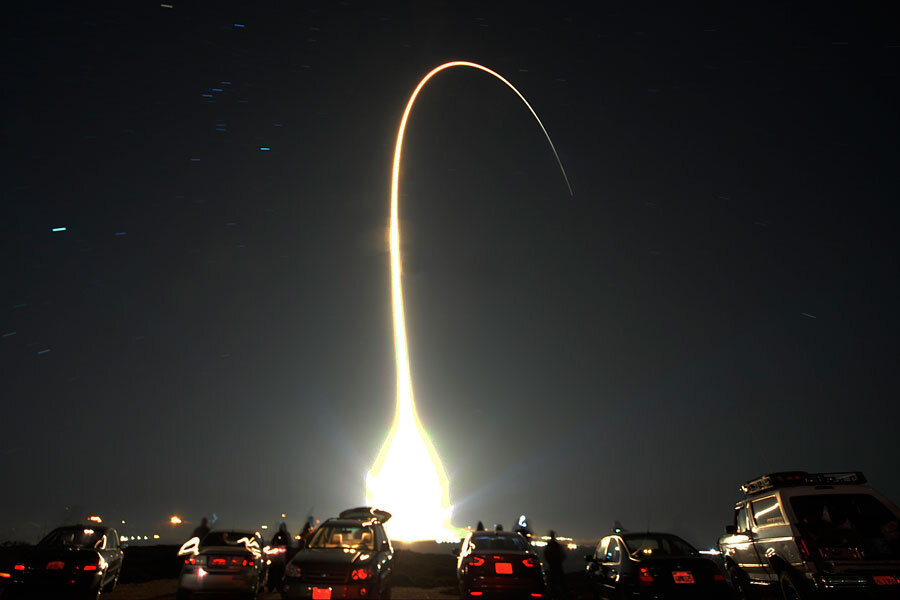Can you put top-secret satellites into orbit? The US Air Force might want to hear from you.
Loading...
| Cape Canaveral, Fla.
The U.S. Air Force released the first of up to eight solicitations for space launch services outside of its controversial, exclusive, multibillion-dollar agreement with United Launch Alliance, a partnership of Lockheed Martin and Boeing.
The solicitation, posted on the Federal Business Opportunities website on Tuesday, is the military's first major commercial outreach for launch services in a decade.
A rocket is needed in 2016 to put a classified satellite into orbit for the National Reconnaissance Office, which operates the nation's spy satellites. Currently, all of the military's key spacecraft are launched on United Launch Alliance Atlas 5 and Delta 4 boosters.
Privately owned Space Exploration Technologies, or SpaceX, filed a lawsuit in April in the U.S. Court of Federal Claims to protest the Air Force's latest sole-source launch contract, an $11 billion award for 36 booster rockets from United Launch Alliance.
The Air Force and United Launch Alliance have asked the court to dismiss the suit, claiming SpaceX missed its window of opportunity to contest the arrangement, which was first announced in 2012.
While SpaceX and the Air Force wrangle in court, they also are closely cooperating to get SpaceX certified to compete for future U.S. military launch contracts.
"If everything goes extremely well ... by December of this year we'll have them certified," General William Shelton, head of Air Force Space Command, said at a joint hearing of the Senate Armed Services and Commerce committees on Wednesday.
"The only (launch services) provider that's really in a serious certification process is SpaceX," Shelton added.
On Tuesday, the Air Force said SpaceX had completed three successful, consecutive launches of its upgraded Falcon 9 rocket. A bevy of engineering reviews, manufacturing assessments and other analysis is pending.
Shelton said the Air Force has 136 people assigned to the SpaceX certification process, and expects to spend about $100 million on the effort.
Certifying SpaceX to fly U.S. military payloads also could alleviate concerns about Russia banning exports of its RD-180 rocket engines, which are used to power the Atlas 5.
Congress is considering bills that include between $25 million and $250 million to assess options and begin work on a new rocket engine. The Obama administration, which opposes the proposal, estimates the engine would cost $4.5 billion.
"Throwing money at a problem where we don't know where we're going is not a good idea at this point," Alan Estevez, who oversees Department of Defense acquisitions, told legislators during Wednesday's hearing, which was webcast.
Optimistically, it would take eight years to get a new engine developed, tested and certified, Estevez added. By that time, the issue could be moot.
The Air Force intends to end its sole-source relationship with United Launch Alliance by Oct. 1, 2017, the start of the 2018 fiscal year, Shelton said.
SpaceX also plans to debut a heavy-lift Falcon rocket next year. If successful, the company, owned and run by technology entrepreneur Elon Musk, would have rockets technically capable of meeting most if not all of the military's launch requirements.
Currently, the Delta 4 and some configurations of Atlas 5 are beyond the Falcon 9's capabilities, Shelton said.
Pressed by U.S. Senator Bill Nelson, a Florida Democrat who chairs the science and space subcommittee, Estevez conceded that it would be substantially cheaper to certify a new launch provider than pay for designing, building and testing a new rocket engine for the Atlas 5.
"Development of new engine and integration costs are obviously much more expensive than the cost to us to certify a new entrant," Estevez said.
SpaceX declined to say whether it intended to bid for the National Reconnaissance Office satellite launch.
"Opening up more National Security Space missions to competition is a step in the right direction and SpaceX welcomes this news," company spokesman John Taylor said in an email.
Proposals are due Aug. 14.
(Editing by Eric Walsh)







